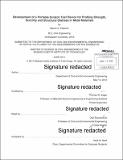| dc.contributor.advisor | Thomas W. Eagar. | en_US |
| dc.contributor.author | Palkovic, Steven D. (Steven David) | en_US |
| dc.contributor.other | Massachusetts Institute of Technology. Department of Civil and Environmental Engineering. | en_US |
| dc.date.accessioned | 2014-09-19T21:43:08Z | |
| dc.date.available | 2014-09-19T21:43:08Z | |
| dc.date.copyright | 2014 | en_US |
| dc.date.issued | 2014 | en_US |
| dc.identifier.uri | http://hdl.handle.net/1721.1/90157 | |
| dc.description | Thesis: S.M., Massachusetts Institute of Technology, Department of Civil and Environmental Engineering, 2014. | en_US |
| dc.description | Cataloged from PDF version of thesis. | en_US |
| dc.description | Includes bibliographical references. | en_US |
| dc.description.abstract | Practicing civil, mechanical, aerospace, petroleum and structural engineers are often faced with the complexity of evaluating the quality and integrity of new or existing structures. Recent academic research has demonstrated that instrumented scratch testing is a viable alternative for determining the strength and ductility of metals without the use of destructive methods involving the extraction of tensile testing specimens. Although the scientific basis for scratch testing is well established, there is a necessity for a simple and robust implementation that avoids the complexities of current methods which require expensive laboratory equipment and sophisticated data processing. A detailed description of the instrumented scratch testing method for characterizing ductile metals is provided, as well as comparisons with existing alternatives. An innovative scratch testing method is proposed and validated to perform a displacement controlled scratch experiment. A portable scratch testing device is designed and developed to utilize the displacement control technique along with specific instrumentation to allow for the continuous measurement of material properties along the length of a scratch during the experiment. The scratch testing device and method are implemented in a scratch experiment on a welded connection. For the first time, a simple experimental procedure allows for the measurement of changes in mechanical properties through the weld, from the base metal, heat-affected zone (HAZ) and filler weld metal. This novel application highlights the unique ability of the scratch testing method to monitor the evolution of localized mechanical properties in areas of interest to practicing engineers. Recommendations for future iterations of the portable scratch tester are provided. | en_US |
| dc.description.statementofresponsibility | by Steven D. Palkovic. | en_US |
| dc.format.extent | 70 pages | en_US |
| dc.language.iso | eng | en_US |
| dc.publisher | Massachusetts Institute of Technology | en_US |
| dc.rights | M.I.T. theses are protected by copyright. They may be viewed from this source for any purpose, but reproduction or distribution in any format is prohibited without written permission. See provided URL for inquiries about permission. | en_US |
| dc.rights.uri | http://dspace.mit.edu/handle/1721.1/7582 | en_US |
| dc.subject | Civil and Environmental Engineering. | en_US |
| dc.title | Development of a portable scratch test device for probing strength, ductility and structural distress in metal materials | en_US |
| dc.type | Thesis | en_US |
| dc.description.degree | S.M. | en_US |
| dc.contributor.department | Massachusetts Institute of Technology. Department of Civil and Environmental Engineering | |
| dc.identifier.oclc | 890198183 | en_US |
